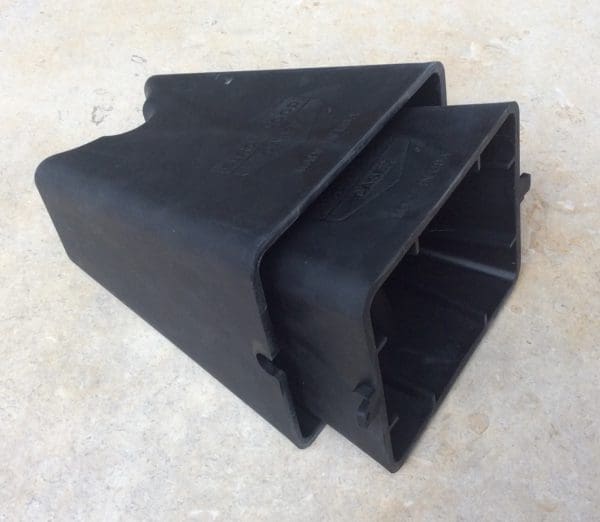It’s said that the most ingenious products are often the simple ones that you look at and say, “Why didn’t I think of that?” Such is the case with the Birchwood Casey Nest Rest.
The Nest Rest is a pair of hollow molded blocks made of rigid rubber. They have very grippy, non-marring surfaces, similar in feel to an inner tube. As the name indicates, they nest together into a very compact package that’s about 6” x 5” x 6” and weighs a smidge over 20 oz.
You can stack the smaller block atop the larger one to create a taller front rest (e.g., for shooting an AR or AK with a 30-round mag or for handgun testing). Each block is topped with a buckhorn-shaped divot that will accommodate just about any shape of handguard or stock.
In simplest use, the Nest Rest provides a stable, hands-free way to hold your long gun at the shooting bench (e.g., during cease-fires or to adjust your scope) or at the workbench (for cleaning or minor work).
For basic bench shooting – say, sighting in a scope or teaching a new shooter – they provide a nicely stable rest with a modicum of elevation adjustment available by moving one or both rests in or out.
Is it as solid as a dedicated gun vise? As recoil-absorbing as a Lead Sled? As easily adjustable and precise as a rear squeeze bag or monopod? Able to be “loaded” like a bipod for quicker followup shots? As cheap as homemade sand bags?
Nope. But for a lightweight, portable, compact, practically indestructible, functional unit with a street price under $25, the Nest Rest is well worth having on hand.
Specifications: Birchwood Casey Nest Rest
Large Rest: 6.6″Hx6″Wx5″D
Small Rest: 4.7″Hx5.5″Wx4.5″D
Pieces nest and lock together to save space.
Soft, non-marring surface.
Small Rest stacks on large rest for additional height adjustment.
Made in USA
MSRP: $30 ($24.54 shipped on Amazon)
Ratings (out of five stars):
Overall rating: * * * *
A simple but clever design that works.







Hint: A vise is a device for holding things tightly. You can hold things tightly with a vice, also – but it can be much more fun.
I was thinking that vices tend more toward consuming and losing than holding, but then I remembered greed and parsimony.
I don’t even notice most of these homonym errors anymore; I go into internet mode and skim for the essence. Saves a lot of time…and my sanity, too.
One that does still get me every time is “muzzle break.” Dude, it’s not breaking anything! (At least we hope not.) It’s braking, as slowing down or reducing muzzle rise.
On topic, I do think this is a nifty little product — now on my to-buy list.
Isn’t shooting at a range mostly supposed to be practice to hunt? I doubt a lot of people will be dangling these from their belt loops walking around the woods.
Heh. (/sarc?) You need to come to our range. 3-gun, cowboy action, silhouette, steel challenge, F-Class, NRA high power. Events just about every weekend, often more than one going on at the same time. 🙂
I’m sure there are folks sighting in a few hunting rifles, but in the members area it is mostly MSRs, bench rest, pistols and 1K Yard range being used.
Chito,
Before you can hone your marksmanship skills (as in shooting technique) for hunting, you first have to be sure that your rifle will put a bullet:
(a) where your sights/scope is pointing, and
(b) that your firearm/ammunition combination produces tight groups.
Most people will not be able to verify either of those objectives shooting offhand.
Look at it this way. Suppose you shoot a 4-inch group at 50 yards. Was the group so large because that is the best that you could aim? Was the group that large because your firearm/ammunition combination shoots large groups? Was it something else?
Shooting from a solid rest tends to eliminate the variable of how consistently you were able to aim at the target when you pulled the trigger.
Right. Most range shooters I see just use rests. Hunting doesn’t usually work that way.
No, shooting at a range is target shooting
Hunters go to the range at the start of hunting season to verify that their rifle is still zeroed
So they need a steady rest to prove that point of aim is still point of impact
Lots of hunters use 2 inches high at 100 yards
That gives you vital zone hits out to 250 yards with no adjustments needed
Target shooters love to adjust turrets
Hunters like to set the scope and forget it
This product seems like a clever idea
The price is right as well
I disagree … $25 is steep for two pieces of molded rubber. If they were about $10, I would buy a set without hesitation. At $25, I’ll pass.
Another reason why garages are so full of crap.
You couldn’t ship a box this size full of air to your door for $10. $25 shipped for anything this size and weight doesn’t seem so bad 😉